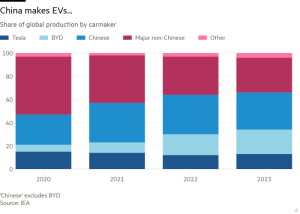Deaths of older people from climate extremes soars, annual review shows
Stay informed with free updates
Simply sign up to the Climate change myFT Digest — delivered directly to your inbox.
Climate change-related hazards have caused death rates among older people to soar and a spike in the risk of infectious diseases as a result of heavy rainfall, an annual audit of health threats from global warming found.
The review by more than 100 scientists published in The Lancet underscores how climate change threatens both survival and quality of life. Low and middle-income countries are hit hardest, it said, as each fraction of a degree rise in global mean temperatures compounds the problems.
“This year’s stocktake of the imminent health threats of climate inaction reveals the most concerning findings yet in our eight years of monitoring,” said Marina Romanello, executive director of the project, known as the Lancet Countdown, at University College London.
“No individual or economy on the planet is immune from the health threats of climate change.”
Heat-related deaths among people over 65 last year, the hottest on record, surged to 167 per cent above the levels in the 1990s, according to the research. This was more than 100 percentage points higher than the increase that would have been expected from population growth alone.
People worldwide were exposed to an all-time high average of 1,512 hours — equivalent to 63 full days — of temperatures that represented at least a moderate risk of heat stress when simply walking around, the scientists said.
Rising temperatures caused the loss of 512bn potential hours of labour last year, a 49 per cent increase on the 1990-9 average, they added — equivalent to roughly 100 hours for every adult on the planet.
The Lancet Countdown was set up to monitor health impacts after the Paris agreement on climate change was adopted in 2015. It draws on the work of 122 experts from 57 academic institutions and UN agencies, including the WHO and the World Meteorological Organization.
Sand and dust storms fuelled by hotter and drier weather present another growing health hazard, the project found. They contributed to a 31 per cent increase in the number of people exposed to dangerously high concentrations of particulate matter between 2018 and 2022, compared with the 2003-2007 period.

People also struggled more to feed themselves adequately because almost 50 per cent of the world’s land area suffered at least one month of drought last year, the researchers found. More than 150mn more people experienced moderate or severe food insecurity across 124 countries assessed in 2022, compared with the 1981-2010 period.
At the same time, more than 60 per cent of the world’s land area saw an increase in extreme rainfall events during the decade from 2014, compared with the 1961-1990 average, the scientists found.
That contributed to rising transmission risks for mosquito-borne diseases such as dengue, which hit an all-time high of more than 5mn reported cases in more than 80 territories last year.
Climate Capital

Where climate change meets business, markets and politics. Explore the FT’s coverage here.
Are you curious about the FT’s environmental sustainability commitments? Find out more about our science-based targets here
#Deaths #older #people #climate #extremes #soars #annual #review #shows








